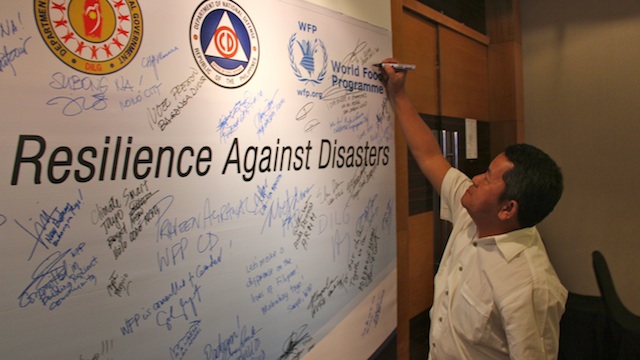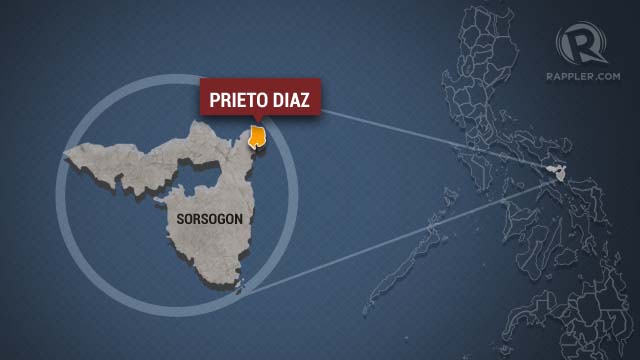SUMMARY
This is AI generated summarization, which may have errors. For context, always refer to the full article.

MANILA, Philippines – When newly-elected Mayor Benito Doma of Prieto Diaz in Sorsogon assumed office, his town did not have a local disaster risk reduction and management office (DRRMO).
The law on disaster risk reduction and management — which passed Congress in 2010 — mandated the creation of the body in every local government. Since then, at least 8 typhoons have hit the town.
“Salamat at walang disaster na dumating sa Sorsogon o Prieto Diaz,” Doma said, noting that the typhoons have not caused devastation so far. (We are thankful that no disaster came to Sorsogon or Prieto Diaz.)
Though his town is rarely hit by strong typhoons, Doma said it is already experiencing environmental change.
The coast along its coastal barangays (villages) is already creeping inland, observed Doma. Of its 23 barangays, 19 face the Albay Gulf and the Pacific Ocean.
“Ang kinakatakutan namin doon ay climate change, ang pagbaba ng aming baybayin,” the mayor said. (We’re afraid of climate change, our shoreline is receding.)
A recent World Bank study reveals that in the coming decades, climate change will lead not only to more intense typhoons and storm surges, but also to higher sea levels.

Greater resilience
But under his watch, Doma does not want to take chances with nature. He personally attended the recently concluded national forum on disaster preparedness and response.
The United Nations World Food Programme (WFP) Philippines organized the forum from July 24-25 in Ortigas, Quezon City with the theme, “Harnessing synergies to build resilience against disasters.”
The two-day forum became a venue for sharing experiences and insights on the following components of disaster preparedness, response, and recovery efforts that best apply to the local and national levels:
- Raising awareness
- Building technical capabilities
- Mitigating community-level risks
- Strengthening infrastructure
- Improving response management
“If greater resilience is built, more lives are saved,” WFP Philippines country director Praveen Agrawal told the nearly 200 participants composed of local executives and planners, nongovernment groups, and national agencies.
Making disaster preparedness ordinary
Agrawal said that WFP builds the capacity of the most vulnerable communities by working with the government and other partners like civil society groups and the academe, to ensure food and nutrition security, while reducing disaster risk and enhancing lives and livelihoods.
Speakers from other national agencies agreed, emphasizing that addressing disaster and climate change should not be isolated from development planning.
Climate Change Commission (CCC) vice chairperson Lucille Sering said that national climate change and disaster reduction plans are not integrated in local government plans.
A World Bank report recently revealed gaps in climate policy efforts across sectors and levels of government that hamper their effectiveness.
READ: Rebuilding Iloilo to become a disaster-resilient LGU
But Albay Gov Joey Salceda, who spoke in the forum, shared how proper coordination down to the community level worked in his province.
“Every day we have a barangay being trained. Make it ordinary,” Salceda said.
Albay is renowned for its community-based efforts that have achieved zero casualty after various natural calamities hit the province.
Family-based
According to Doma, when he goes back to Prieto Diaz, he will create an office that will be responsible for disaster risk reduction and management, as well as climate change adaptation. He also recognized the need to formulate a workable and attainable plan.
“Iyong natutunan ko rito sa forum, siguro magpa-family-based, capability-building ng mama, papa, ate, at kuya. Kailangan nilang ma-internalize ang concept, ang plan,” Doma said.
(I think we will introduce a family-based approach. That is what I learned from the forum — building the capability of the mother, father, eldest daughter and son. They need to internalize the concept and plan.)
Doma understands the magnitude of the need and the complexity of the requirements for mayors like him to enable their cities and municipalities to withstand the impact of climate change.
He said he has to start somewhere. – Rappler.com
Add a comment
How does this make you feel?
There are no comments yet. Add your comment to start the conversation.